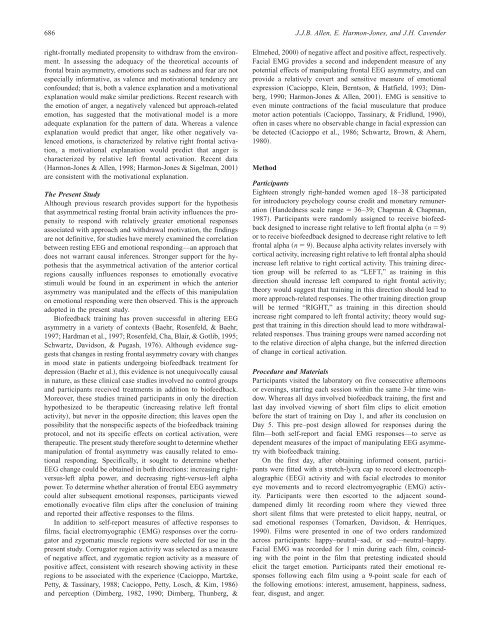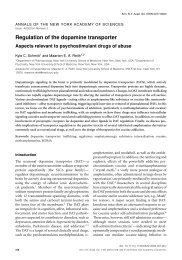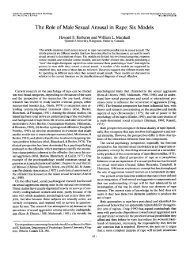Manipulation of frontal EEG asymmetry through biofeedback alters ...
Manipulation of frontal EEG asymmetry through biofeedback alters ...
Manipulation of frontal EEG asymmetry through biofeedback alters ...
Create successful ePaper yourself
Turn your PDF publications into a flip-book with our unique Google optimized e-Paper software.
686 J.J.B. Allen, E. Harmon-Jones, and J.H. Cavender<br />
right-<strong>frontal</strong>ly mediated propensity to withdraw from the environment.<br />
In assessing the adequacy <strong>of</strong> the theoretical accounts <strong>of</strong><br />
<strong>frontal</strong> brain <strong>asymmetry</strong>, emotions such as sadness and fear are not<br />
especially informative, as valence and motivational tendency are<br />
confounded; that is, both a valence explanation and a motivational<br />
explanation would make similar predictions. Recent research with<br />
the emotion <strong>of</strong> anger, a negatively valenced but approach-related<br />
emotion, has suggested that the motivational model is a more<br />
adequate explanation for the pattern <strong>of</strong> data. Whereas a valence<br />
explanation would predict that anger, like other negatively valenced<br />
emotions, is characterized by relative right <strong>frontal</strong> activation,<br />
a motivational explanation would predict that anger is<br />
characterized by relative left <strong>frontal</strong> activation. Recent data<br />
~Harmon-Jones & Allen, 1998; Harmon-Jones & Sigelman, 2001!<br />
are consistent with the motivational explanation.<br />
The Present Study<br />
Although previous research provides support for the hypothesis<br />
that asymmetrical resting <strong>frontal</strong> brain activity influences the propensity<br />
to respond with relatively greater emotional responses<br />
associated with approach and withdrawal motivation, the findings<br />
are not definitive, for studies have merely examined the correlation<br />
between resting <strong>EEG</strong> and emotional responding—an approach that<br />
does not warrant causal inferences. Stronger support for the hypothesis<br />
that the asymmetrical activation <strong>of</strong> the anterior cortical<br />
regions causally influences responses to emotionally evocative<br />
stimuli would be found in an experiment in which the anterior<br />
<strong>asymmetry</strong> was manipulated and the effects <strong>of</strong> this manipulation<br />
on emotional responding were then observed. This is the approach<br />
adopted in the present study.<br />
Bi<strong>of</strong>eedback training has proven successful in altering <strong>EEG</strong><br />
<strong>asymmetry</strong> in a variety <strong>of</strong> contexts ~Baehr, Rosenfeld, & Baehr,<br />
1997; Hardman et al., 1997; Rosenfeld, Cha, Blair, & Gotlib, 1995;<br />
Schwartz, Davidson, & Pugash, 1976!. Although evidence suggests<br />
that changes in resting <strong>frontal</strong> <strong>asymmetry</strong> covary with changes<br />
in mood state in patients undergoing bi<strong>of</strong>eedback treatment for<br />
depression ~Baehr et al.!, this evidence is not unequivocally causal<br />
in nature, as these clinical case studies involved no control groups<br />
and participants received treatments in addition to bi<strong>of</strong>eedback.<br />
Moreover, these studies trained participants in only the direction<br />
hypothesized to be therapeutic ~increasing relative left <strong>frontal</strong><br />
activity!, but never in the opposite direction; this leaves open the<br />
possibility that the nonspecific aspects <strong>of</strong> the bi<strong>of</strong>eedback training<br />
protocol, and not its specific effects on cortical activation, were<br />
therapeutic. The present study therefore sought to determine whether<br />
manipulation <strong>of</strong> <strong>frontal</strong> <strong>asymmetry</strong> was causally related to emotional<br />
responding. Specifically, it sought to determine whether<br />
<strong>EEG</strong> change could be obtained in both directions: increasing rightversus-left<br />
alpha power, and decreasing right-versus-left alpha<br />
power. To determine whether alteration <strong>of</strong> <strong>frontal</strong> <strong>EEG</strong> <strong>asymmetry</strong><br />
could alter subsequent emotional responses, participants viewed<br />
emotionally evocative film clips after the conclusion <strong>of</strong> training<br />
and reported their affective responses to the films.<br />
In addition to self-report measures <strong>of</strong> affective responses to<br />
films, facial electromyographic ~EMG! responses over the corrugator<br />
and zygomatic muscle regions were selected for use in the<br />
present study. Corrugator region activity was selected as a measure<br />
<strong>of</strong> negative affect, and zygomatic region activity as a measure <strong>of</strong><br />
positive affect, consistent with research showing activity in these<br />
regions to be associated with the experience ~Cacioppo, Martzke,<br />
Petty, & Tassinary, 1988; Cacioppo, Petty, Losch, & Kim, 1986!<br />
and perception ~Dimberg, 1982, 1990; Dimberg, Thunberg, &<br />
Elmehed, 2000! <strong>of</strong> negative affect and positive affect, respectively.<br />
Facial EMG provides a second and independent measure <strong>of</strong> any<br />
potential effects <strong>of</strong> manipulating <strong>frontal</strong> <strong>EEG</strong> <strong>asymmetry</strong>, and can<br />
provide a relatively covert and sensitive measure <strong>of</strong> emotional<br />
expression ~Cacioppo, Klein, Berntson, & Hatfield, 1993; Dimberg,<br />
1990; Harmon-Jones & Allen, 2001!. EMG is sensitive to<br />
even minute contractions <strong>of</strong> the facial musculature that produce<br />
motor action potentials ~Cacioppo, Tassinary, & Fridlund, 1990!,<br />
<strong>of</strong>ten in cases where no observable change in facial expression can<br />
be detected ~Cacioppo et al., 1986; Schwartz, Brown, & Ahern,<br />
1980!.<br />
Method<br />
Participants<br />
Eighteen strongly right-handed women aged 18–38 participated<br />
for introductory psychology course credit and monetary remuneration<br />
~Handedness scale range 36–39; Chapman & Chapman,<br />
1987!. Participants were randomly assigned to receive bi<strong>of</strong>eedback<br />
designed to increase right relative to left <strong>frontal</strong> alpha ~n 9!<br />
or to receive bi<strong>of</strong>eedback designed to decrease right relative to left<br />
<strong>frontal</strong> alpha ~n 9!. Because alpha activity relates inversely with<br />
cortical activity, increasing right relative to left <strong>frontal</strong> alpha should<br />
increase left relative to right cortical activity. This training direction<br />
group will be referred to as “LEFT,” as training in this<br />
direction should increase left compared to right <strong>frontal</strong> activity;<br />
theory would suggest that training in this direction should lead to<br />
more approach-related responses. The other training direction group<br />
will be termed “RIGHT,” as training in this direction should<br />
increase right compared to left <strong>frontal</strong> activity; theory would suggest<br />
that training in this direction should lead to more withdrawalrelated<br />
responses. Thus training groups were named according not<br />
to the relative direction <strong>of</strong> alpha change, but the inferred direction<br />
<strong>of</strong> change in cortical activation.<br />
Procedure and Materials<br />
Participants visited the laboratory on five consecutive afternoons<br />
or evenings, starting each session within the same 3-hr time window.<br />
Whereas all days involved bi<strong>of</strong>eedback training, the first and<br />
last day involved viewing <strong>of</strong> short film clips to elicit emotion<br />
before the start <strong>of</strong> training on Day 1, and after its conclusion on<br />
Day 5. This pre–post design allowed for responses during the<br />
film—both self-report and facial EMG responses—to serve as<br />
dependent measures <strong>of</strong> the impact <strong>of</strong> manipulating <strong>EEG</strong> <strong>asymmetry</strong><br />
with bi<strong>of</strong>eedback training.<br />
On the first day, after obtaining informed consent, participants<br />
were fitted with a stretch-lycra cap to record electroencephalographic<br />
~<strong>EEG</strong>! activity and with facial electrodes to monitor<br />
eye movements and to record electromyographic ~EMG! activity.<br />
Participants were then escorted to the adjacent sounddampened<br />
dimly lit recording room where they viewed three<br />
short silent films that were pretested to elicit happy, neutral, or<br />
sad emotional responses ~Tomarken, Davidson, & Henriques,<br />
1990!. Films were presented in one <strong>of</strong> two orders randomized<br />
across participants: happy–neutral–sad, or sad—neutral–happy.<br />
Facial EMG was recorded for 1 min during each film, coinciding<br />
with the point in the film that pretesting indicated should<br />
elicit the target emotion. Participants rated their emotional responses<br />
following each film using a 9-point scale for each <strong>of</strong><br />
the following emotions: interest, amusement, happiness, sadness,<br />
fear, disgust, and anger.










